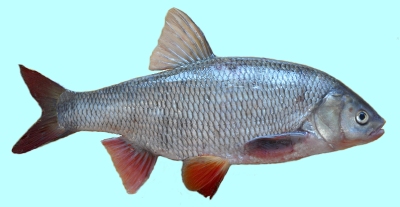|
|
Ide fish, Orfe fish, its habitats, characteristics, fishing methods and techniques.
The ide (also id) or orfe, Leuciscus idus, are active surface-dwelling shoaling fishes that grow to around 40cm (16) in length. They Ides are predators, eating insects, crustaceans, mollusks, and small fish. In the spring, they move into rivers to spawn over gravel or vegetation; the eggs may be found sticking to stones or weeds in shallow water. They are natives of large rivers so they have a high oxygen requirement. Orfe are very sensitive to certain medications, especially those containing copper. Ask your retailer, or check the packaging, to ensure any treatments are safe. They are best kept in a small group in a spacious, well-filtered pond.
A combination of understanding the fish and the techniques used to catch them will help you to hook more fish to the end of your line. Better knowing and understanding of the fish that you are trying to catch will make you a more successful angler, whether you are fishing for trout on a river or surfing on the beach or trolling on the open water.

|
The ide (also id) or orfe, Leuciscus idus, also known as
Язь in Russian, is a freshwater fish of the family Cyprinidae (Carp family) found across northern Europe and Asia. It occurs in larger rivers, ponds, and lakes, typically in schools. These fish are particularly abundant in the Danube and in the big rivers in Europe, where they are fished commercially, and they are also found in the brackish waters of the Baltic Sea.
|
Description
The Ide has a relatively deep minnow-shaped body that is moderately thick, a small head with a thin terminal mouth and large eyes with a brassy yellow iris. The back of this fish is dark greyish blue, while its sides are silvery and its belly is white. The dorsal fin is greyish blue while the other fins are reddish; the caudal fin is darker in color and is deeply forked. Ides live in shoals in the lower reaches of large rivers, in valley reservoirs and in lakes; they have also been used to stock fishponds. Older adults have a raised humped back nape. Lateral-line scales number 55-63. The snout is blunt and the mouth is small, terminal, and oblique. Gill rakers are short, widely spaced, and number 10-14 on the first arch. The pharyngeal teeth are conic, smooth (not serrated), and arranged in 2 rows (usually 3,5-5,3). The dorsal fin is short, with 7-10 soft dorsal rays, and usually originates over the posterior part of the pelvic fin base. The anal fin has 9-13 soft rays. Adults are dark on the back and sides above the lateral line. The lower parts of the sides are light or silvery. The fins are red, especially the anal fin and paired fins.
The Ide is a medium-sized fish, typically growing 30-43 cm and weighing 680 g. Maximum size is about 1 m. and up to 8 kg. The body has a typical cyprinid shape and generally silvery appearance, while the fins are a pinkish red in varying degrees. The tail and backfin can be greyish. In older and bigger fish the body color can turn to yellow/bronze. Ide can be distinguished from most native North American cyprinids by the following combination of characteristics: pharyngeal teeth 3,5-5,3, no barbels, lateral-line scales 55-63, and usually 8 branched dorsal rays.
Habitat and Habits
Typical habitat includes pools and slow-flowing or still waters; however, deeper waters are sometimes used in winter. They occur in schools in clear pools of medium to large rivers as well as ponds and lakes. The Ide inhabits the lower reaches of large rivers, lowland lakes, and brackish estuaries of rivers, adding that it schools in clean, deep water, moving into shallow freshwater to spawn in the spring. The species is not confined to freshwaters, and is found in the Baltic Sea. Ide spent the first year of life in the river, and then joined older fish migrating to the Baltic Sea during the summer months. The species returned to the river in the autumn and remained near the mouth and in the lower reaches throughout the winter. After spawning in the spring, Ide returned to coastal waters.
Ide feeds on zooplankton, aquatic insect?s larvae and adults, cladocerans, trapped floating insects, worms, spawn of other fishes, small mollusks, diatoms, fish fry, and filamentous algae. Other dietary items include macrophytes, detritus, and small fishes.
Spawning
Ide have a life span of 10-15 years and become sexually mature when 3 to 5 years old. Ide inhabiting a reservoir in a more northern location (Finland) reached maturity at a larger size and older age (6-7 years). Males are reaching maturity at a size about 3 cm smaller than females. In the spring, April to June, spawning begins once the water reaches a temperature of about 5-14 ?C for 2-3 days. Ide spawns in weedy or sandy shallow areas where the adhesive eggs attach to stones or vegetation. Adult individuals migrate in shoals to their spawning grounds. Small spawning tubercles appear on the head, body and pectoral fins of the females at this time. Fecundity ranged from 39,000-114,000 eggs (average 88,000) in the Dnieper (Russia), from 15,000-125,000 eggs in Romania and from 42,000-260,000 eggs in Sweden. Fecundity increases linearly with fish mass. The eggs are laid on a gravelly or sandy bed, on aquatic plants or on fine tree roots. Spawning is a very stormy process, as the fish whirl about in their gleaming gold nuptial dress. Eggs hatch in about 5 days at 18-22 ?C, but incubation time increases in cooler temperatures. Optimal temperature for embryonic development is 12-18 ?C.
Fishing Methods.
They are popular with anglers and have quite tasty flesh. The Orfe, the golden variety of the Ide, is an artificially bred form (just as the Goldfish is an artificial form of the Carp).
|
|
|

